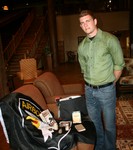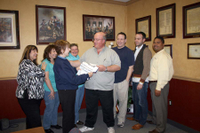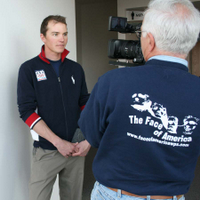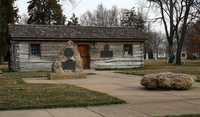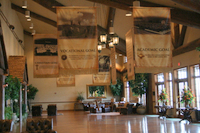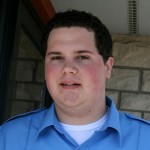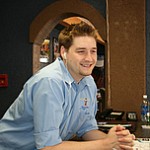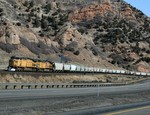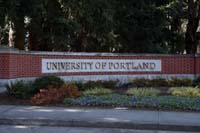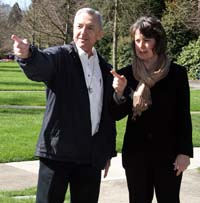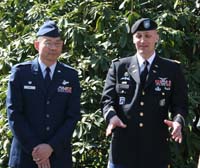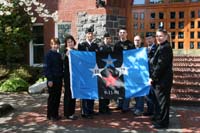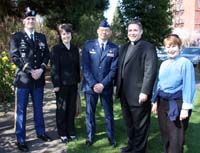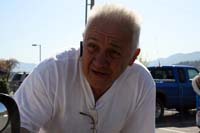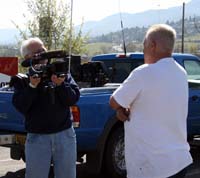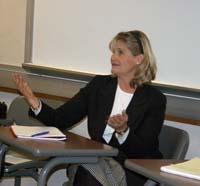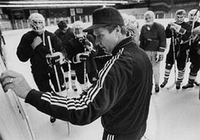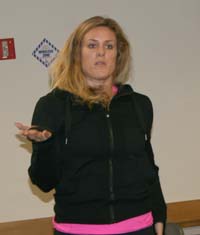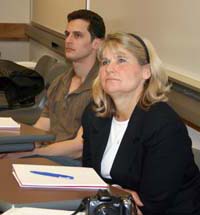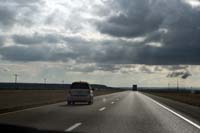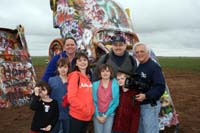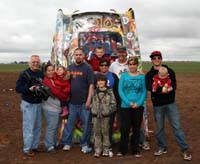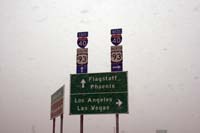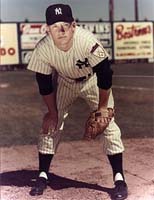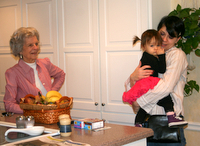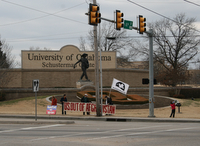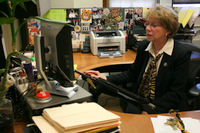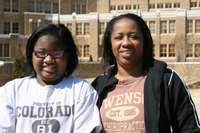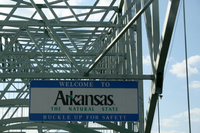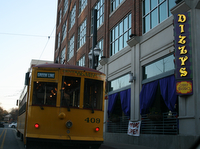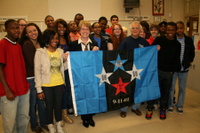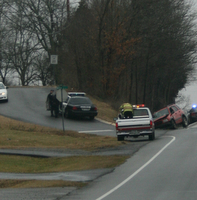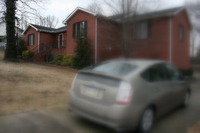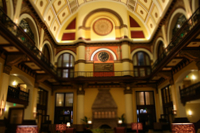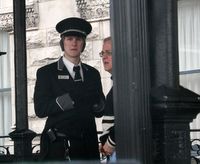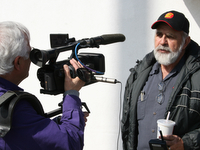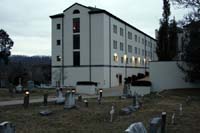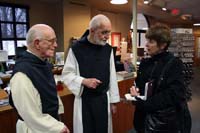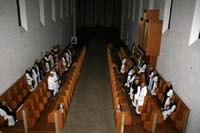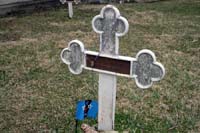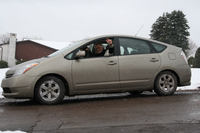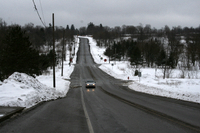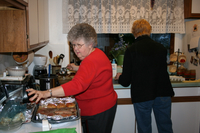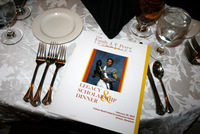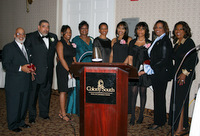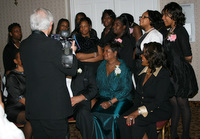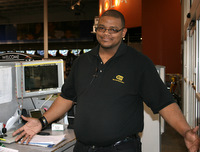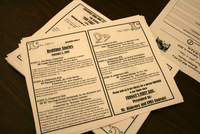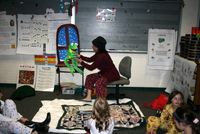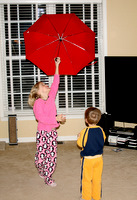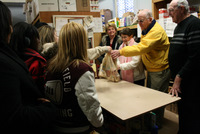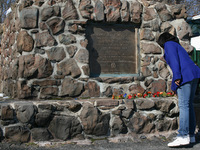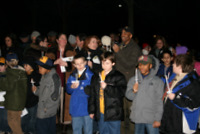Searching for the Face of America in The Heartland: Point Lookout, Missouri
By Tony Mussari
Photographs By Kitch Loftus Mussari
I do not believe there is a problem in this country or the world today which could not be settled if approached through the teaching of the Sermon on the Mount. Harry S. Truman
My journey to the College of the Ozarks began in my grandmother’s kitchen more than 60 years ago. I don’t remember the date, but I do remember the event. My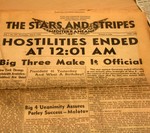 uncles were reminiscing about their experiences in World War 2. They did not say much about the gore of the war or the battles that left permanent marks on their souls, but they did something that made a permanent impression on me.
uncles were reminiscing about their experiences in World War 2. They did not say much about the gore of the war or the battles that left permanent marks on their souls, but they did something that made a permanent impression on me.
When we were around, they were quick to show us the artifacts of war. I loved the brass buttons and the uniform patches. I was fascinated by the chevrons and the lapel pins.
All these years later, the little boy who worshipped these men is a retired teacher and a grandfather in the twilight of his years. His search for the Face of America took him to  the College of the Ozarks, the epicenter of an innovative program that brings college students and World War II veterans together for international travel to battlefields where the teenagers of the 1940s literally saved the world.
the College of the Ozarks, the epicenter of an innovative program that brings college students and World War II veterans together for international travel to battlefields where the teenagers of the 1940s literally saved the world.
In sacred places like Normandy, Anzio, Iwo Jima and so many others, 16 million men and women earned the title The Greatest Generation. 310,979 earned it by dying for their country. 672,377 earned it by being injured in battle, and 12,780 earned it by being declared missing in action.
My wife and I came to Point Lookout, Missouri, to talk with students about their experiences with the last remaining survivors of this war. We wanted to know what they learned about the war, the men who fought it, and its importance, if any, in this time and place. We wanted to know what they learned about themselves and their country.
During our visit, we talked with five students who accompanied World War II veterans to European and Pacific battlefields, and five students who were involved in other activities sponsored by a college that is determined to provide an education of the head, heart and hands.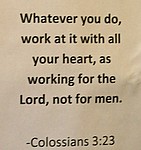
The College of the Ozarks is a faith-based school. The animating spirit of this campus is best summarized in 17 words from Colossians: “Whatever you do, work at it with all your heart, as working for the Lord, not men.”
Our experience here was pleasant, positive, productive and profound.
Our conversation began with a business major, Riley Webb, who explained the 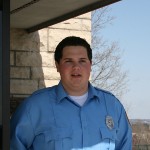 unique circumstance that brought him to Hard Work U. as it is known here. Riley works 15 hours a week in the security office at the entrance to the campus. Like all of the students here he works one full week each semester. He pays for his books, but he does not pay any tuition.
unique circumstance that brought him to Hard Work U. as it is known here. Riley works 15 hours a week in the security office at the entrance to the campus. Like all of the students here he works one full week each semester. He pays for his books, but he does not pay any tuition.
It’s a formula for success. This year, the College of the Ozarks has received 5,000 applicants for 300 positions in the 2011 freshman class. That’s an impressive statistic by any standard.
Jamie Jernigan is a senior majoring in information systems. She helped us to better understand the five core values of the college: Academic, Vocational, Christian, Patriotic and Cultural. Jamie participated in one of the battlefield trips sponsored by the college and the Greatest Generation Foundation. She called it the most important learning moment of her college career. It helped her to better understand the significance of what these men did. It humbled her to be in their presence.
Cultural. Jamie participated in one of the battlefield trips sponsored by the college and the Greatest Generation Foundation. She called it the most important learning moment of her college career. It helped her to better understand the significance of what these men did. It humbled her to be in their presence.
Jamie hopes that her love for WWII veterans “will inspire more people to think more about patriotism.”
Ashlyn Moore is a sophomore. She works in the public relations office. 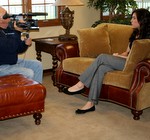 Ashlyn went to the 65th anniversary celebration at Normandy. During the trip, she recorded her thoughts in a blog. During our visit, she talked about the lasting impact of her experience. For Ashlyn Moore, it was a life-changing experience. It was an opportunity to develop a better understanding of words like freedom, patriotism, courage, honor and sacrifice for country. For the rest of her life, she intends to tell the story of June 4, 1944, and the 10 veterans who helped her to understand the significance of that day.
Ashlyn went to the 65th anniversary celebration at Normandy. During the trip, she recorded her thoughts in a blog. During our visit, she talked about the lasting impact of her experience. For Ashlyn Moore, it was a life-changing experience. It was an opportunity to develop a better understanding of words like freedom, patriotism, courage, honor and sacrifice for country. For the rest of her life, she intends to tell the story of June 4, 1944, and the 10 veterans who helped her to understand the significance of that day.
Blake DeHaan is a senior. He is a thoughtful and very polished young man. There is honesty and integrity in his eyes. He wants to become a law enforcement officer.
Blake went to Normandy with a suitcase filled with questions about the war and the things that happened during the largest battle ever fought. He came home with a briefcase filled with memorabilia that he will treasure for the rest of his life.
After our conversation, he carefully removed each item and he displayed them on a couch in the lobby of the Keeter Center. It was a moment of honor, respect and admiration. Before we parted, this impressive young man took me to a gallery of pictures on the main floor of the Keeter Center, and he showed me the priceless picture that was taken on the famous beach at Normandy with his veteran.
Lukas Mathews is a chemistry major. He went to Iwo Jima. For this young 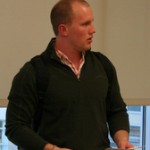 man who wants to become a doctor, the trip made him much more aware of the horrible things that happen in war. It helped him to develop a sense of compassion for the men who fought in the South Pacific. It also gave him a much better appreciation of the human cost of war. This is something he now knows in a very personal way. His brother was recently deployed to the Middle East. For the rest of his life, he will remember these two events, and they will give him perspective.
man who wants to become a doctor, the trip made him much more aware of the horrible things that happen in war. It helped him to develop a sense of compassion for the men who fought in the South Pacific. It also gave him a much better appreciation of the human cost of war. This is something he now knows in a very personal way. His brother was recently deployed to the Middle East. For the rest of his life, he will remember these two events, and they will give him perspective.
In the years ahead, this very special young man will become a medical doctor. He will heal the sick and care for the suffering. He will also honor his responsibility to keep the story of the Greatest Generation alive and well.
On a special evening in one of the newest buildings on campus, students who had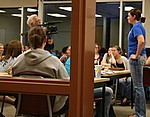 been selected to go on future patriotic trips came together to hear Rebecca Wright talk about her experience. Watching Rebecca through the viewfinder of my camera, I saw a young woman with poise, grace and natural leadership skills. Rebecca was well organized and very effective as she took her audience through all of the steps of the journey they would take.
been selected to go on future patriotic trips came together to hear Rebecca Wright talk about her experience. Watching Rebecca through the viewfinder of my camera, I saw a young woman with poise, grace and natural leadership skills. Rebecca was well organized and very effective as she took her audience through all of the steps of the journey they would take.
During the question and answer period, I waited for the appropriate moment, and then I asked Rebecca three questions that enabled her to address the issues in our Face of America project. She responded in a heartfelt way that touched my heart and produced this response, “Rebecca, you are indeed a genuine Face of America.”
As Kitch and I were leaving the orientation session, a sign in a classroom on the second floor caught my attention. The 11 letters spelled a word that was prominently displayed on a  classroom wall 1,200 miles east of this place. It read FLEXIBILITY. It produced memories of another time, another place, another classroom and another faith-based college, King’s College, that I called home for 37 years. It was an ironic and precious moment.
classroom wall 1,200 miles east of this place. It read FLEXIBILITY. It produced memories of another time, another place, another classroom and another faith-based college, King’s College, that I called home for 37 years. It was an ironic and precious moment.
At Sunday service in a packed Gothic cathedral that towers over this campus, Kitch and I learned about two spring break service trips: a mission trip to a Navajo Indian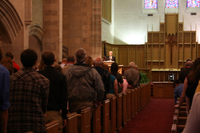 reservation in New Mexico and a trip the 80-member chorus took to Washington, Philadelphia and New York City. The students who talked about these experiences were articulate, compelling and very impressive.
reservation in New Mexico and a trip the 80-member chorus took to Washington, Philadelphia and New York City. The students who talked about these experiences were articulate, compelling and very impressive.
After a thoughtful sermon by Daniel K. Chinn about the importance of humility in the Christian tradition, and a powerful and poignant presentation by worship leader and chorus director Gregg Bush I could feel the canvas of this visit changing. I wanted to learn more about these students and what they experienced. In the days ahead, I would get an opportunity to do just that.
It was our good fortune to meet a gracious and talented junior, Stephanie  Fitzgerald, who sat with us in the shadow of Williams Memorial Chapel to tell her story of renewal and transformation as she sang “America the Beautiful” on the lawn of the US Capitol in Washington, and at St Paul’s Church in lower Manhattan adjacent to Ground Zero.
Fitzgerald, who sat with us in the shadow of Williams Memorial Chapel to tell her story of renewal and transformation as she sang “America the Beautiful” on the lawn of the US Capitol in Washington, and at St Paul’s Church in lower Manhattan adjacent to Ground Zero.
Stephanie wants to be a music teacher and a performer. She has a voice that is absolutely beautiful, and a personality that is welcoming, kind and generous. Stephanie, Kitch and I had an instant connection. She shared her enormous talent with us and she connected us with the college chorus for a moment that we will never forget.
Stephanie is a young woman who represents her family and her college with dignity and class. She will be an excellent teacher.
Elske Oldeboer is an exchange student from Holland. She is studying public relations and marketing. We met Elske at lunch in the student dining room. Kitch was drawn to Elske. She found her to be a bright, charming, sophisticated young woman.
She found her to be a bright, charming, sophisticated young woman.
Elske accepted our invitation to become a part of our project, and we were the beneficiaries of her insights about America. During her interview, she helped us to better understand how our country and our people are seen in Europe. She also helped u to frame a question that would become central to other interviews.
During her stay at the College of the Ozarks, Elske has learned much about America. Her story is positive and it is filled with interesting insights.
Hannah Ramsey is studying to become a nurse. After a few moments in her 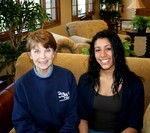 presence, I knew she would be an excellent nurse. Hannah is positive and thoughtful. She is a very caring person, and she has an appreciation for the wonderful opportunities she has been given at the College of the Ozarks.
presence, I knew she would be an excellent nurse. Hannah is positive and thoughtful. She is a very caring person, and she has an appreciation for the wonderful opportunities she has been given at the College of the Ozarks.
Hannah is a natural conversationalist, and she makes one feel very comfortable no matter what the setting. In my opinion, she personifies the spirit and then purpose of this college. She is faith-based person, a welcoming person, an industrious person, a well educated person and a patriotic person.
Like all of the students we met, Hannah is a genuine person. There are no hidden agendas. It’s all sincerity, all integrity, and all willingness to help.
At the College of the Ozarks, the vision is clear and purposeful. From the office of the president to the office of the restaurant manager, the goal is to develop citizens of Christ-like character who are well educated, hardworking and patriotic.
We came to Point Lookout, Missouri, with three objectives. We wanted to meet Dr.  Fred Mullinax. We wanted to interview students in his special program for veterans. We wanted to present the National 9/11 Remembrance Flag to Dr. Jerry Davis. We leave this special
Fred Mullinax. We wanted to interview students in his special program for veterans. We wanted to present the National 9/11 Remembrance Flag to Dr. Jerry Davis. We leave this special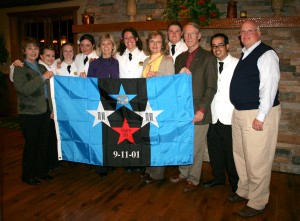 place today with memories that are rich and inspirational, sounds from a chorus that will fill our hearts and minds with positive emotions, friendships that will endure, and a portrait of the Face of America that is practically perfect in every way.
place today with memories that are rich and inspirational, sounds from a chorus that will fill our hearts and minds with positive emotions, friendships that will endure, and a portrait of the Face of America that is practically perfect in every way.
As I drive our Prius along Opportunity Way 16 words from a quotation will be playing against the melody of An American Anthem: “How lucky I am to have known someone who was so hard to say good-bye to.”
President Harry Truman was right. “It is understanding that gives us the ability to have peace.”
Until the next time, we hope that all of your stories have happy endings.
Please keep us in your prayers and always know of our gratitude for your help, kindness and support.
Please provide feedback to:
tmussari@gmail.com
